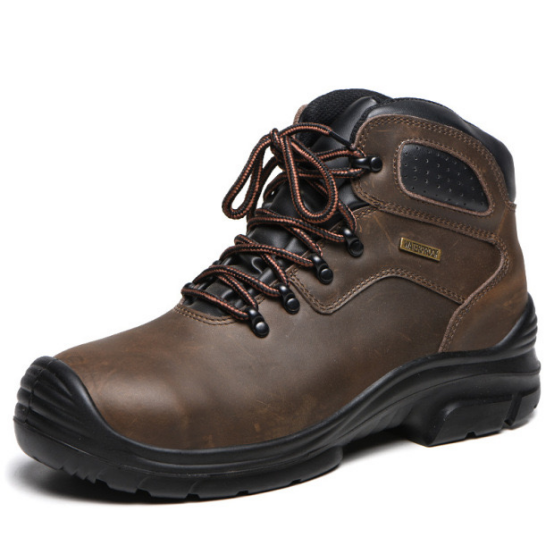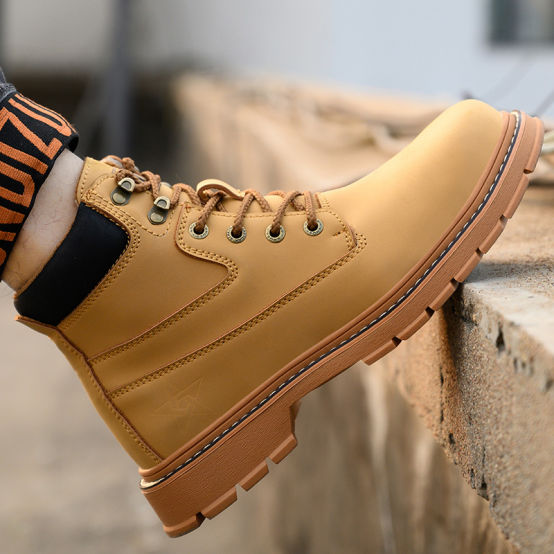Mining is one of the most hazardous industries. Workers are faced with a wide range of dangers such as falling objects, uneven surfaces, electrical hazards, and extreme temperatures. To prevent accidents and maintain productivity, high quality mining shoes are crucial.
Mining shoes are protective and durable in these extreme conditions. Equipped with steel or composite toe caps, slip-resistant soles, and electrical hazard protection, they can safeguard miners’ feet from a variety of threats. Additionally, mining shoes cab also help reduce fatigue so well that workers can focus more on their tasks safely.
Why It Matter?
Below is a table outlining the types of mining shoes that are best suited for addressing each potential risk in mining:
| Potential Risk | Recommended Type of Mining Shoes | Description |
| Foot Injuries from Falling Objects | Steel-Toe or Composite-Toe Boots | Provides reinforced toe protection to guard against falling or crushing objects. |
| Puncture Wounds | Puncture-Resistant Boots with Kevlar Soles | Prevents sharp objects from penetrating the sole of the shoe. |
| Slipping on Wet or Uneven Surfaces | Slip-Resistant and Oil-Resistant Boots | Soles designed to maintain grip on slippery or uneven surfaces. |
| Exposure to Electrical Hazards | Electrical Hazard (EH) Rated Boots | Insulated to protect against electrical shocks when working near electrical equipment. |
| Foot Fatigue and Discomfort | Comfort-Focused Boots with Cushioning and Arch Support | Designed with extra padding and support to reduce fatigue during long shifts. |
| Chemical Burns or Contamination | Chemical-Resistant Boots | Made from materials that protect feet from harmful chemicals and contaminants. |
| Extreme Temperatures | Heat-Resistant or Insulated Boots | Protects feet from extreme heat or cold, depending on the environment. |
| Ankle Injuries | Boots with Ankle Support and High Cut | High-cut boots provide extra support to prevent ankle sprains or twists. |
This table provides a clear guide on which types of mining shoes are ideal for mitigating specific risks commonly found in mining environments.

Crazy Horse Boots with Ankle Support
Material Considerations
Considering the unique risks of mining shoes, we shall be cautious when selecting the right upper material, midsoles and outsoles.
Natural Leather or Synthetic Leather
Natural Leather Mining Shoes
- Durability: Highly durable and able to withstand harsh mining conditions such as abrasions, dirt, and wear.
- Water Resistance: Leather can be treated to repel water, keeping feet dry in wet environments.
- Comfort: Provides flexibility and molds to the foot over time for a custom fit.
- Heat and Cold Resistance: Offers decent insulation against extreme temperatures.
Synthetic Leather Mining Shoes
- Durability: Strong and resistant to scratches and scuffs, while being lighter than full-grain leather.
- Waterproofing: Generally more water-resistant than natural leather, making it ideal for wet environments.
- Chemical Resistance: More resistant to chemicals, oils, and solvents often found in mining areas.
- Lightweight: Easier on the feet, reducing fatigue during long shifts.

Rubber Outsole or PU Outsole
Rubber outsoles mining shoes are the best overall choice for traction, durability, and resistance to chemicals and oils; PU outsoles mining shoes are great for lightweight comfort and shock absorption, though rubber may be better for very slippery conditions.
Kevlar Midsole or Steel Midsole
Kevlar Midsole for Mining Shoes
Kevlar is much lighter than steel. So the kevlar midsole mining shoes are better for long shifts. Also, the Kevlar material is more flexible. So it would be more comfortable to wear on bending, climbing, or walking uneven surfaces. Moreover, Kevlar offers better insulation against extreme temperatures (both hot and cold). What’s more, it can also provide excellent protection against sharp objects like nails, metal shards, or debris commonly found in mining environments. Unlike steel, Kevlar won’t corrode when exposed to moisture or chemicals.
Steel Midsole for Mining Shoes
Steel midsole mining shoes offer the highest level of puncture resistance, especially against strong or very sharp objects such as metal or large shards of rock in mining. However, the steel midsole is significantly heavier and less flexible than Kevlar. It might not be so comfortable for miners to wear when walking or moving around in confined spaces or uneven ground.
How to Choose the Right Mining Shoes for Surface Mining and Underground
Best Shoes for Surface Mining:
- Steel or Composite Toe Boots: For impact protection.
- Rubber Outsoles with Deep Treads: For slip resistance on rocky, uneven, or oily surfaces.
- Kevlar Midsoles: Lightweight but puncture-resistant to deal with sharp rocks and debris.
- Waterproofing: Essential to handle outdoor exposure to rain or muddy conditions.
Best Shoes for Underground Mining:
- Steel Toe or Composite Toe Boots: Essential for protecting against falling objects.
- Waterproofing and Slip Resistance: Rubber outsoles with slip resistance for wet, slippery, or muddy underground conditions.
- Kevlar or Steel Midsoles: To provide puncture resistance, as sharp objects like rocks are common.
- EH Rated: Electrical hazard-rated boots to protect against electrical shocks.
- Insulated Boots: For protection against cold underground temperatures.
- High-Cut Boots with Ankle Support: For better support and protection when navigating uneven or confined underground areas.
Conclusion
The right pair of mining shoes can prevent serious injuries caused by falling objects, sharp debris, slips, and electrical hazards, while also offering comfort and support during long, physically demanding shifts.Whether it’s the choice of steel or composite toes, Kevlar or steel midsoles, or rubber outsoles with deep treads, mining shoes should be selected based on the unique risks and demands of the work environment. To place an order on mining shoes, click here to send us an enquiry.


